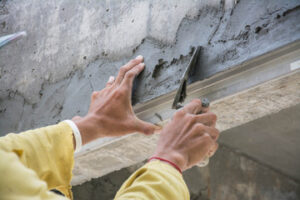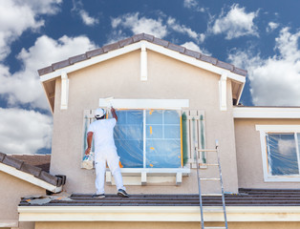The resulting structure must be durable regardless of the method used to repair concrete damage. This includes physical properties such as cracking resistance (drying shrinkage and modulus of elasticity), permeability, and freeze-thaw durability.

The key to a durable repair is bond strength. This is accomplished by a thorough surface preparation and a long, moist curing period. For professional help, contact Concrete Repair Eau Claire.
The key to a successful concrete repair is preparation. This means determining the type of damage and selecting an appropriate repair product. It also includes cleaning the surface, if necessary. This helps the new material adhere to existing concrete. In addition, etching the concrete can improve adhesion and reduce the tendency for concrete to curl or shrink once it cures.
Blowholes, voids and surface defects must be filled to ensure good bond with the new repair materials. For this purpose a wide range of concrete repair products is available. The choice should be made on the basis of the type of damage and the concrete substrate. For example, a flexi-patch or polymer-modified repair mix is well suited for small honeycomb areas that are difficult to chip out.
For the correct application of overlays and coatings, the concrete must have a consistent surface profile (CSP). To achieve this it is important to mechanically prepare the surfaces to remove cement laitance and existing coatings and to smooth out the existing concrete using shotblasting or grinding. It is particularly important to eliminate divots or pits in the concrete, because these weak points can lead to future problems.
Once the concrete has been cleaned, it must be rehydrated. This is done by spraying the surface with water. This process should be repeated several times until the surface is saturated and ready for the application of the new repair materials.
Before placing the repair materials the surface must be dampened again. This is to prevent the newly placed material from pulling moisture from the concrete it sits on. It may be necessary to cover the area with a damp burlap sheet or plastic film for several hours to ensure that the surface is kept moist.
Once the concrete has been repaired it must be protected from extreme weather conditions. This is to avoid moisture loss and drying shrinkage cracking. It is also a good idea to protect the repair from foot traffic while it is curing. This will help the new repair to remain intact, and it will slow down the recurrence of damage in that location.
Repair Materials
One of the most important factors to consider is what kind of repair material to use. There are a number of different options available, including portland cement mortar and grout, concrete patching compounds, latex modifiers, and epoxy systems. The right choice will depend on the specific needs of the project. For example, if the structure is prone to cracking, it might be best to use a cement-based product that has high early mechanical strength and low shrinkage. On the other hand, if the cracks are caused by corrosion, it might be necessary to use a corrosion-resistant repair system.
Another important factor to consider is the compatibility of the repair materials with the concrete substrate to which they will be bonded. The repair material must be able to withstand the conditions that the existing concrete is exposed to, such as temperature, humidity, chemical attack, and exposure to UV radiation. The repair materials should also have a coefficient of thermal expansion similar to that of the existing concrete, so that stresses do not transfer from the interface between the repair and the substrate.
Lastly, the repair materials should be easy to work with, especially for the field workers who will be applying them. They should be easy to mix and apply, and they should be able to set up quickly so that the repairs can be completed on time.
Portland cement and its mortars are the most commonly used repair materials for concrete structures. These materials are cheap, easily available, and have good workability properties. However, they have a poor bond with concrete substrates, and the quality of the repair is often limited by the ability of the material to adhere to the substrate.
The permeability of the repair material is also an important consideration. The material should have a low permeability to prevent the ingress of harmful chemicals. It should also be able to hydrate rapidly, so that it can form a strong interfacial bond with the existing concrete.
In order to improve the bond between the repair material and the concrete substrate, a number of techniques have been developed. Karima et al. [60] investigated the bond strength and failure mode of the interface between a special concrete with 100% limestone filler and the concrete substrate using the split and flexural bond test methods. They found that the special concrete had good adhesion to the substrate.
Mixing
Concrete repair is one of the most challenging jobs a contractor can face. It requires extensive research and careful selection of the right products, proper site preparation and planning, and patience to wait for the correct curing conditions. The process can be very frustrating, especially when it isn’t completed as quickly as you would like.
If you find that you have minor surface damage – cracks that do not extend down to the steel reinforcement, for example – you may be able to repair them by simply filling in the cracks with dry cement. This type of repair will provide a temporary fix for the surface but will not prevent the cracks from reoccurring.
For concrete repair to last, the cracked area must be fully consolidated and bond with the surrounding sound concrete. This will require the use of a concrete mix that is suitable for partial and full depth repairs, such as QUIKRETE EA Concrete Repair Mix with Super Plasticizer. The mix is designed to improve durability by reducing shrinkage and increasing strength. This is accomplished by incorporating fly ash and silica fume that also improve pumpability.
In addition, the concrete must be brought to saturated surface dry (SSD) condition. This will allow the new concrete to hydrate properly and reduce potential bond breakers such as air pockets or surface delamination.
Before applying any of the concrete repair materials, you should hose down the damaged area to get rid of any dirt or debris that can cause problems. This is especially important on a warm day when the concrete will rob water from the new repair mix to hydrate and harden.
A good concrete surface has a smooth finish and an acceptable level of strength to accommodate dynamic loads. This can be achieved with a wood or sponge float for a smooth finish or with a burlap-drag for a rough surface.
If you have a large area of concrete that has sustained significant damage, it may be necessary to remove the damaged section and pour a new slab. This can be very expensive, but it may be the best option if the damaged concrete is severely deteriorated and is not conducive to repair.
Application
If concrete damage isn’t addressed promptly, it can worsen over time and result in structural damage or even collapse. A thorough evaluation is needed to determine the cause of the damage, classify it as major or minor and select an appropriate repair method.
Once the repair method is selected, it is important to select a product that meets the specific needs of the damaged concrete surface. This includes material handling properties, rheology and cure times. Concrete repair products are available in a range of pumpability, slump, flow and hang / stickiness to meet the installation procedures used in each repair project such as: form and pour repairs, pre-placed aggregate concrete repairs, tremie concrete repairs, dry pack repairs, trowel applied vertical and overhead concrete repairs and low velocity wet sprayed shotcrete repairs.
In addition to these critical characteristics, the concrete repair materials must have adequate tensile and compressive strengths to handle the load and environmental stresses that will be exerted on the repaired structure. The material should also be freeze-thaw resistant and have good thermal resistance to reduce differential shrinkage.
Concrete repair projects can be complex and challenging. However, by following proper preparation and application techniques, it is possible to ensure a high quality concrete repair. This will help minimize future damage and save both time and money in the long run.
It is also recommended to use a concrete sealant to protect the repaired surface from moisture absorption, harsh weather conditions and dirt. Regular cleaning and sealing will prolong the life of the concrete.
